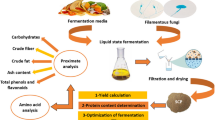Summary
From the foregoing brief account of exploratory work conducted with rice, it is obvious that the carbohydrate of whole brown rice can serve well as a substrate for the synthesis of fungal protein. Thus, usingDactylium dendroides (I-108) as the agent of synthesis, it was possible to increase the total quantity of protein in rice by a factor of 2.29 and, usingTrichoderma sp. (I-193), by a factor of 2.85. In the 1962/63 season, world production of paddy rice was 277,088,000 tons containing about 41 billion pounds of protein. If it is conservatively estimated that protein can be increased by a factor of 2 by a fungus conversion process, then from the 62/63 crop a total of 82 billion pounds of protein could have been produced. Alone, the rice crop contained sufficient protein (on quantitative grounds) to meet the annual requirements of 787 million people whereas the potential existed for supplying the needs of 1.5 billion people—nearly one-half of the present world population. In view of experiences gained with other crude sources of carbohydrate, it seems reasonable to predict that by further search for higher yielding fungi and proper manipulation of environmental conditions a four-fold increase is a distinct possibility.
Similar content being viewed by others
Literature Cited
Gray, W. D. 1949. Initial studies on the metabolism ofHansenula anomala (Hansen) Sydow. Am. Jour. Bot.36: 475–480.
— 1962a. Microbial protein for the space age. Devel. Indus. Microbiol.3: 63–71.
-.1962b. Fungi as a nutrient source. Biologistics for Space Systems Symposium, May 1962. Technical Documentary Report No. AMRL-TDR-62-116, October 1962. Biomedical Laboratory 6570th Aerospace Medical Research Laboratories, Aerospace Medical Division, Air Force Systems Command, Wright-Patterson Air Force Base, Ohio. pp. 356–381.
— & Abou-El-Seoud, M. O. 1966. Fungal protein for food and feeds. II. Whole sweet potato as a substrate. Econ. Bot.20 (2): 119–126.
— & — 1966. Fungal protein for food and feeds. III. Manioc as a potential crude raw material for tropical areas. Econ Bot.20 (3): 251–255.
— & —. 1966. [1967]. Fungal protein for food and feeds. IV. Whole sugar beets or beet pulp as a substrate. Econ. Bot.20 (4): 372–376.
Nutritional Data. 1963. Publ. by H. J. Heinz Co., Pittsburgh, Pa.
Scrimshaw, N. S. & Behar, M. 1961. Protein malnutrition in young children. Science133: 2039–2047.
Author information
Authors and Affiliations
Additional information
Supported by the Mershon Committee for Education in National Security and the Rockefeller Foundation.
Rights and permissions
About this article
Cite this article
Gray, W.D., Karve, M.D. Fungal protein for food and feeds v. rice as a source of carbohydrate for the production of fungal protein. Econ Bot 21, 110–114 (1967). https://doi.org/10.1007/BF02897858
Received:
Issue Date:
DOI: https://doi.org/10.1007/BF02897858




